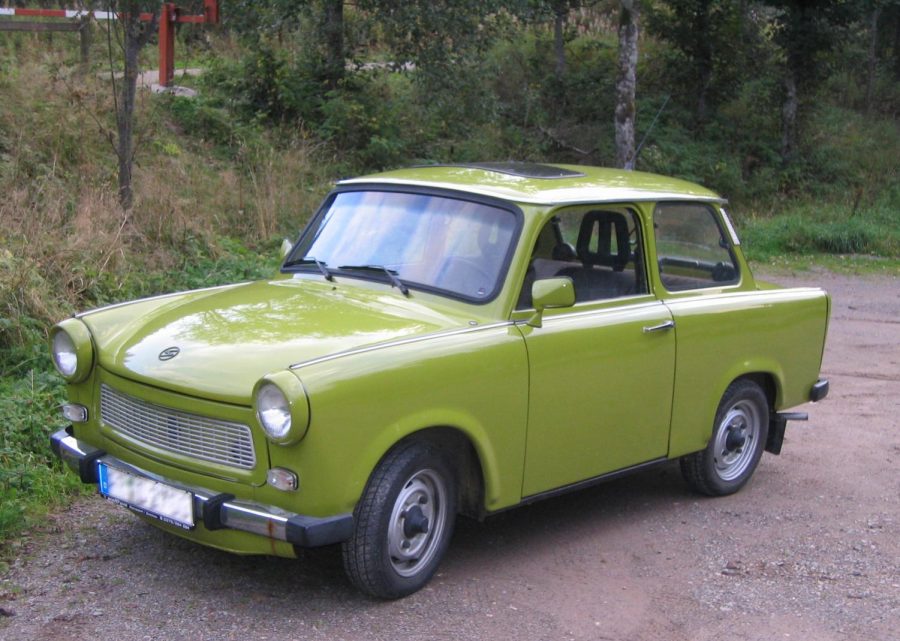The Trabant, Germany’s Socialist Legacy
October 7, 1989. West German Embassy, Prague, Czechoslovakia.
A multicolored sea of cars clogs streets and parking lots, just like normal. The only difference is that these are all abandoned sedans and hatchbacks. And they all carry the Trabant badge.
This odd occurrence will be witnessed by all the countries touching the former German Democratic Republic after November 9, 1989, as thousands upon thousands of former East Germans leave, many to West Germany.
Unlike in Prague, however, the East German government will not send drivers to take the cars back—not when former East Germans now have choice in the automobiles they drive.
Why wouldn’t they want Trabants? And why would owners gleefully abandon them?
The answer lies in the question. In 1957, production of Trabants began in East Germany. The Trabant was East Germany’s people’s car, like the Volkswagen was for West Germany. At the time, they were fairly innovative cars, in terms of the materials used.
The hood, trunk, roof, and many other components were made of Duroplast, which is basically layers of cotton, wool, glass cloth, and paper pressed together with extreme heat, giving Soviet textile waste a second life.
And, giving the car a 1,300 pound weight. But that’s not just from the Duroplast, but also the two cylinder, 595-cc, two stroke engine that puts out 27 horsepower when fueled with 50:1 gas and two stroke oil mix. You know, the stuff you put in a chainsaw or hedge trimmer.
Because the Trabant, or Trabi as it popularly known, had such a small engine, it didn’t need wasteful extra parts to “appease the bourgeois,” stuff like a water pump, radiator, oil filter or pump, camshaft or valves, timing belt, distributor cap for the ignition, thermostat or fan belt. All stuff we expect to have in our cars.
So it should be implied that it wouldn’t have many creature comforts. However, you could draw fresh air into the car, and hot air from the engine. The fan speed was controlled by the accelerator. (In other words, it didn’t have a fan.)
However, the Trabant was a pretty safe car, despite having a six gallon gas tank above the engine mounted to the firewall. In fact, because of the extensive use of Duroplast, which is almost two times a strong as steel, at 35 MPH the Trabant scored better in crash tests than modern european cars, including Peugeot minivans and the Ford Escort. Not bad for a car that was unchanged in its original design dating to 1957.
One downside, though, of the Trabant’s “economy” engine, was pollution. Both noise and environmental. The engine is actually rather quiet, drivers reported. The noise came from the exhaust, along with blue smoke containing 4 times as much pollution as a modern six cylinder car.
At least when you were driving you sat in front of your exhaust, so you only had to breathe in the smoke from the Trabi in front of you. Seems like to good way to discourage tailgating.
And speaking of driving, it really wasn’t all that bad. You sat upright and had a very very small accelerator pedal, but the four speed transmission was synchronized, so you didn’t have to double clutch. The Trabant also came with rack and pinion steering, instead of recirculating ball. In the United States, rack and pinion wouldn’t be fully accepted until the mid 1980s. And back in Germany, Mercedes and BMW held out even longer—until the early 1990s.
The Trabant is part of the legacy of socialism, but also something more. It’s a testament to the people of East Germany, who would wait for years in order to buy one, and their desire for mobility and freedom during a time when you needed to file an itinerary with the government in order to take a vacation.
Well, actually, I guess that is a legacy of socialism. So when the Berlin Wall fell, and East Germans had the opportunity to use the Autobahn, they needed something that could do better than 70 MPH. Also they wanted cars with better suspensions. Apparently they weren’t a big fan of the car tipping into corners.
Even so, for 3.1 million people, the Trabant was living a dream—personal, private mobility at a time when the government imposed collectivism and public use of goods and services was an inescapable part of life—at least until you got into your Trabi.








